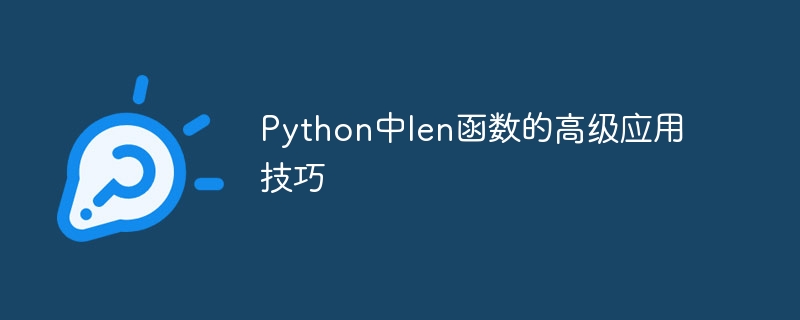Home >Backend Development >Python Tutorial >In-depth exploration of the application skills of len function in Python
In-depth exploration of the application skills of len function in Python
- 王林Original
- 2024-01-28 08:10:171131browse

Advanced application skills of the len function in Python
In Python programming, the len() function is a very commonly used function, mainly used to calculate strings, lists, and tuples Wait for the length of the iterable object. However, in addition to regular usage, the len() function also has some advanced application techniques that can help us better process data and optimize code. This article introduces these advanced application techniques through specific code examples.
1. The len() function is used to determine whether it is empty.
The len() function can be combined with conditional judgment statements to determine whether an iterable object is empty. The code example is as follows:
# 判断字符串是否为空
text = ''
if len(text) == 0:
print("字符串为空")
else:
print("字符串不为空")
# 判断列表是否为空
lst = []
if len(lst) == 0:
print("列表为空")
else:
print("列表不为空")
# 判断元组是否为空
tpl = ()
if len(tpl) == 0:
print("元组为空")
else:
print("元组不为空")In the above example, it is determined whether the iterable object is empty by judging whether the return value of the len() function is 0. This technique is often used in code to easily judge and process data.
2. The len() function is used to calculate the number of key-value pairs in the dictionary
When calculating the length of the dictionary, you can use the len() function to calculate the number of key-value pairs in the dictionary. The code example is as follows:
# 计算字典中键值对的数量
data = {'name': 'Tom', 'age': 20, 'gender': 'male'}
print("字典中键值对的数量为:", len(data))In the above example, the len() function is used to calculate the number of key-value pairs in the dictionary data and print the result.
3. The len() function is used to calculate the slice length
When using the slicing operation, you can use the len() function to calculate the length of the slice and further process the data. The code example is as follows:
# 计算切片长度
text = "Python is a powerful programming language"
slice_text = text[7:14]
print("切片长度为:", len(slice_text))In the above example, the length of the slice slice_text is calculated through the len() function and the result is printed.
4. The len() function is used to quickly calculate the number of loops
When using loops for iterative operations, you can use the len() function to quickly calculate the number of loops and improve the efficiency of the code. The code example is as follows:
# 快速计算循环次数
lst = [5, 2, 8, 10, 7]
for i in range(len(lst)):
print("第", i+1, "次循环")
# 使用enumerate函数进行遍历
for index, value in enumerate(lst):
print("第", index+1, "次循环")In the above example, the length of the list lst is calculated through the len() function, and then the number of loops is determined. This makes it easier to perform loop operations without having to manually specify the number of loops.
To sum up, in addition to the conventional usage, the len() function also has some advanced application skills. We can use the len() function to determine whether an iterable object is empty, calculate the number of key-value pairs in a dictionary, calculate the length of a slice, and quickly calculate the number of loops. These techniques can help us better process data and optimize code, making the code more efficient. I hope this article is helpful to Python beginners.
The above is the detailed content of In-depth exploration of the application skills of len function in Python. For more information, please follow other related articles on the PHP Chinese website!

